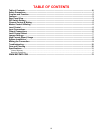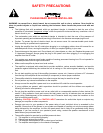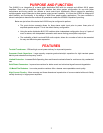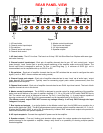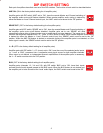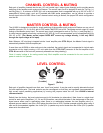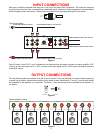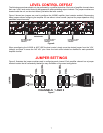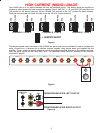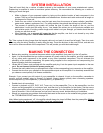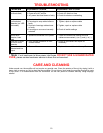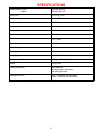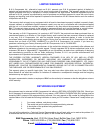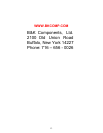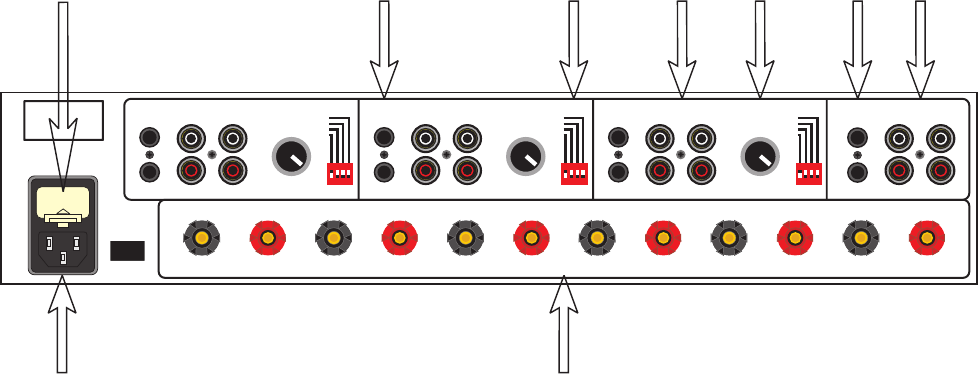
3
REAR PANEL VIEW
VOLTAGE
A.C.LINE
FUSE
CAUTION: FORCONTINUED
PROTECTION AGAINSTRISK
OF FIREREPLACE ONLY
WITH SAMETYPE 15A 250V.
OUT 6
PLUS PLUS PLUS PLUS PLUSMINUS MINUS MINUS MINUS MINUS
OUT 5 OUT 4 OUT 3 OUT 2 OUT 1
SERIAL
NUMBER
PLUS MINUS
1/23/45/6 OUTOUTOUT
CTRL 1/2CTRL 3/4CTRL 5/6
135 INININ
OUTOUTOUT INININ
246
INININ
OUT
MASTER
CONTROL
OUT
IN
BUS
OUT
IN
IN
1234
ON
1234
ON
1234
ON
MINMINMIN MAXMAXMAX
AMPON AMPON AMPON
L+R L+R L+R
SENSE SENSE SENSE
BUS BUS BUS
1234
ON
1234
ON
1234
ON
LEVELLEVELLEVEL
OUTOUTOUT
AMPON
8
9
1
2
4
3
5
6
7
Figure 1
1. AC fuse holder 6. Master control input/output
2. Channel control input/output 7. Bus inputs and outputs
3. Dip switches 8. AC input receptacle
4. Channel inputs and outputs 9. Speaker outputs
5. Channel level control
1. AC fuse holder - The AC Line fuse. The fuse is an 8 Amp / 250 Volt Slow Blow fuse. Replace with same type
and value fuse only.
2. Channel control input/output - Each pair of amplifier channels has its own 1/8” mini control input / output
(pass through) ‘Local’ control jack to provide remote switching of the amplifier audio mute on/off feature. The
control input circuit is designed to work as Tip Pos. (+) and Ring Neg. (-). A minimum of 5VDC @ 1 mA is
recommended, and is compatible with up to 24V AC or DC.
3. Dip switches - Each pair of amplifier channels has its own DIP switches that are used to configure the audio
signal (‘Local’ or ‘BUS’, mono or stereo and muting control).
4. Channel inputs and outputs - Each pair of amplifier channels has its own ‘Local’ set of audio input / output
(pass through) RCA connections. Typically used for connecting signal patch cables (interconnects) from the
preamplifier to the amplifier.
5. Channel level control - Each pair of amplifier channels has its own DUAL input level control. The level of both
amplifier channels is set via this control.
6. Master control input/output - The AV2600 is designed to provide control for single switching of the amplifier
audio mute on/off feature on any pair of amplifier channels (1-2, 3-4 or 5-6) with it’s DIP switch ‘MASTER’ set to
ON. The control input circuit is designed to work as Tip Pos. (+) and Ring Neg. (-). A control source capable of
sourcing a minimum of 5 VDC @ 1 mA is recommended, and is compatible with up to 24V AC or DC.
(The Master control output DOES NOT source any voltage directly, it will only PASS through the input
voltage at it’s input).
7. Bus inputs and outputs - In a similar fashion to the Master control input, the AV2600 has a provision for a
stereo audio distribution ‘BUS’. This BUS allows stereo inputs to source audio to amplifier channels (1-2, 3-4 or 5-
6) when the DIP switch ‘BUS’ is set to ON. Simultaneously, buffered ‘BUS’ stereo audio outputs are provided to
allow audio distribution and system expansion.
8. AC Input receptacle - Connect the supplied AC power cord to the amplifier.
9. Speaker outputs - ‘Five way’ binding post terminals allow support for various speaker wire termination. To
prevent damage to the speakers or amplifier, always verify there is no possibility of shorting multiple speaker
terminals together.





